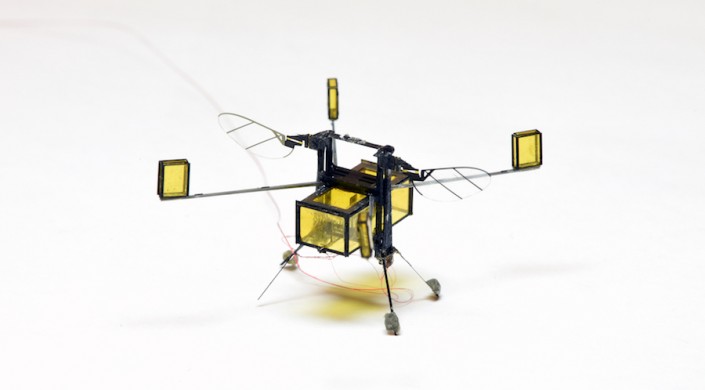The updated model is the work of the university’s John A Paulson School of Engineering and Applied Sciences (SEAS) and Wyss Institute for Biologically-Inspired Engineering. Modelled on insects, the tiny device uses wings to propel itself through water towards the surface. Once there, water is collected in a buoyancy chamber where an electrolytic plate produces oxyhydrogen, lifting the wings just off the water.
Surface tension keeps the robot upright as the wings start to flap, then a sparker ignites the combustible oxyhydrogen, propelling RoboBee into the air. The robot is also able to transition from air to water. According to the researchers, hybrid aerial-aquatic robots such as this could be used for environmental exploration and search & rescue.
“This is the first microrobot capable of repeatedly moving in and through complex environments,” said Yufeng Chen, a former graduate student at the SEAS Microrobotics Lab and first author of the paper, which appears in Science Robotics.
“We designed new mechanisms that allow the vehicle to directly transition from water to air, something that is beyond what nature can achieve in the insect world.”

One of the biggest challenges was figuring out how to escape the water’s surface tension, a daunting task when dealing with the micro scale. According to the Harvard team, the tension is more than 10 times the weight of the RoboBee and three times its maximum lift.
“By modifying the vehicle design, we are now able to lift more than three times the payload of the previous RoboBee,” said Chen.
“This additional payload capacity allowed us to carry the additional devices including the gas chamber, the electrolytic plates, sparker, and buoyant outriggers, bringing the total weight of the hybrid robot to 175 milligrams, about 90mg heavier than previous designs. We hope that our work investigating tradeoffs like weight and surface tension can inspire future multi-functional microrobots – ones that can move on complex terrains and perform a variety of tasks.”




Glasgow trial explores AR cues for autonomous road safety
They've ploughed into a few vulnerable road users in the past. Making that less likely will make it spectacularly easy to stop the traffic for...